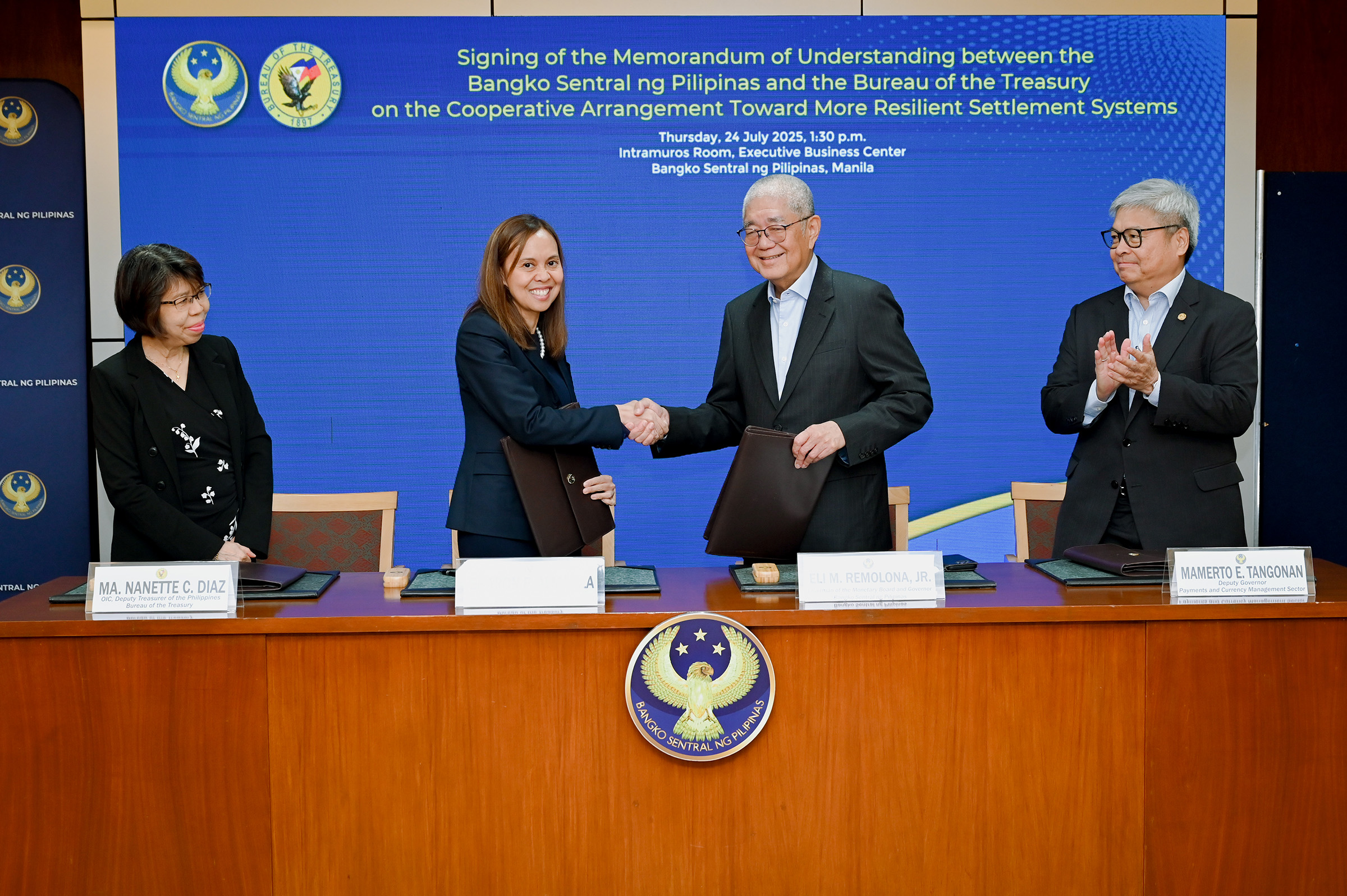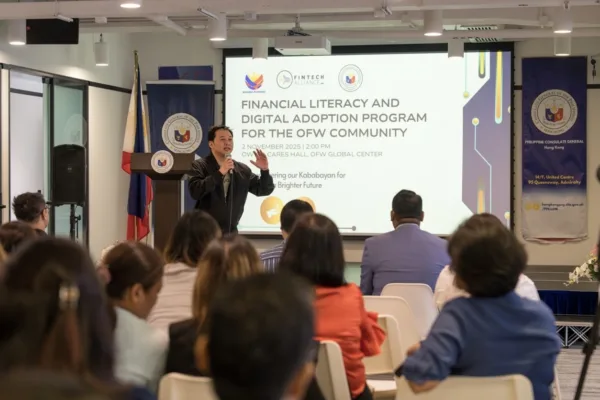The Bangko Sentral ng Pilipinas (BSP) is taking a proactive step to secure the country’s financial future, signing a key agreement with the Bureau of the Treasury (BTr) to strengthen critical market infrastructure.
This move to bolster resilience comes as new data from the central bank reveals a robust and expanding financial sector, with Other Financial Corporations (OFCs) recording significant growth in the first quarter of 2025.

BSP Governor Eli M. Remolona, Jr. (3rd from left) shakes hands with National Treasurer Sharon P. Almanza (2nd from left). The two agencies reinforced its strategic partnership recently through a new memorandum of understanding. Also with the Governor are BSP Deputy Governor Mamerto E. Tangonan (rightmost) and BTr Officer-in-Charge Deputy Treasurer Ma. Nanette C. Diaz.
The collaboration, formalized through a Memorandum of Understanding (MOU) signed on July 24, 2025, is aimed at fortifying systems essential for government securities trading and large-value fund transfers. These two functions are vital cogs in the nation’s financial machinery, ensuring the smooth and secure movement of trillions of pesos through the economy.
The agreement focuses on the BSP’s Peso Real-Time Gross Settlement (RTGS) System, 1 known as PhilPaSSPlus, and the BTr’s National Registry of Scripless Securities (NRoSS), 2 along with related systems that facilitate a seamless Delivery versus Payment (DvP) mechanism and intraday settlements.
The partnership, signed by BSP Governor Eli M. Remolona, Jr. and Treasurer of the Philippines Sharon P. Almanza, highlights a commitment to shared responsibility. “It’s to tell us that we have work to do, and we have to work together to do that work,” Governor Remolona emphasized, underscoring the collaborative effort required to deepen the country’s capital markets and manage systemic risk.
BSP survey reveals robust growth in non-banking financial sector

This strategic fortification of the financial system is particularly timely, as it coincides with a new report from the BSP showcasing the sector’s impressive health. Preliminary data from the Other Financial Corporations Survey (OFCS) for the first quarter of 2025 paints a picture of a booming and increasingly influential segment of the economy.
Other Financial Corporations, which include a diverse group of entities such as investment funds, financial auxiliaries, insurance corporations, and pension funds, saw their domestic assets swell to a staggering ₱10.6 trillion. 3
The growth was not just large in scale, but also in momentum. The OFCs’ domestic assets expanded by a solid 4.9%from the previous quarter’s ₱10.1 trillion and by an even more impressive 14.6% from the previous year’s ₱9.2 trillion. Similarly, the sector’s liabilities, which are primarily composed of stocks, bonds, and other debt instruments, climbed to ₱11.2 trillion, marking a 6.2% quarter-on-quarter increase and a substantial 16.2% year-on-year growth.

The OFCS data provides a clear rationale for the BSP and BTr’s proactive measures. A significant portion of OFC investments — ₱2.7 trillion to be exact — is in government-issued securities, the very instruments whose trading infrastructure the new MOU aims to secure.
The sector also holds ₱3.1 trillion in claims on depository corporations (banks) and has extended ₱4.8 trillion in claims to other sectors, including loans to households and equity in nonfinancial corporations.
Furthermore, the sector is growing its presence on the international stage. The OFCS report highlights a positive position against foreign entities, with OFCs’ net foreign assets reaching ₱0.6 trillion by the end of Q1 2025. This figure represents a remarkable 52.8% year-on-year increase, signaling the growing strength and global relevance of the Philippines’ non-banking financial sector.
In a financial landscape that is both expanding and becoming more complex, the joint effort by the BSP and BTr provides a crucial layer of confidence. The two stories, when viewed together, reveal a financial ecosystem that is not only experiencing robust growth but is also being carefully managed and fortified to ensure its stability and resilience for the future.
—
[1] https://www.bsp.gov.ph/Pages/PAYMENTS%20AND%20SETTLEMENTS/PhilPaSS/PhilPaSS-Overview.aspx
[2] https://www.treasury.gov.ph/?page_id=64888
[3] Non-market investment funds are collective investment schemes that raise capital by issuing shares or units to the public, with the proceeds primarily invested in long-term financial and non financial assets. Other financial intermediaries provide financial services by incurring liabilities —excluding deposits or similar instruments — and acquire financial assets through market-based transactions. Financial auxiliaries support the financial system by engaging in activities related to financial intermediation, although they do not own the underlying assets or liabilities involved. Meanwhile, captive financial institutions and money lenders offer financial services wherein most of their assets or liabilities are not actively traded in open financial markets, typically serving specific clients or engaging in non-market-based financial operations.








